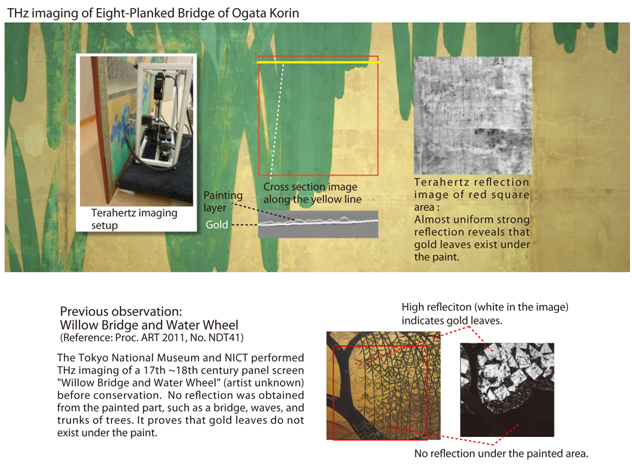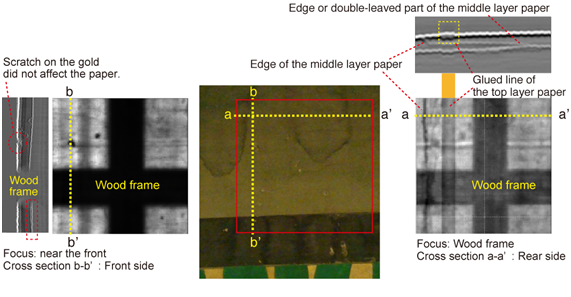The National Institute of Information and Communications Technology (NICT, President: Dr. Hideo Miyahara), Tokyo and the Metropolitan Museum of Art, NY investigated a masterpiece of Ogata Korin, "Eight-Planked Bridge”, a pair of six-panel folding screens, ca 1710 (See Fig. 1) by using terahertz (THz) imaging.
The THz imaging system is portable and the measurement was performed in the storage room of the Metropolitan Museum of Art.
Fig. 2 shows the THz reflection from the surface (the corresponding area appears in the red square) of “Eight-Planked Bridge” and the cross section along the yellow line. The grey square image proved that the reflection from the area where the leaves were painted is as same as that from the gold area. The cross section image indicated the thickness of the paint which is around 0.6 mm. That thickness can be achieved by painting from fine pigment to coarse pigment, layer by layer. The THz reflection from the painted area in the masterpiece such as under the bridge or flowers is as same as that from the gold area. These results revealed that the entire panels were covered by gold as preparation. If there is no gold ground under the paint, no reflection is obtained under the painted area, as in the example of a part of "Willow Bridge and Water Wheel" of the Tokyo National Museum, placed below in Fig. 2, only whose square gold foil gives strong reflection. On the other hand, according to the conservation report on "Kakitsubata zu” of the Nezu Museum, there's no gold ground under the painted area. Thus, these two masterpieces turned out to be created by different techniques.
As THz waves cannot pass through the gold surface, observation from backside is useful to examine internal structure. Fig. 3 shows the THz reflection image and the cross section of the layers of “Eight-Planked Bridge”. The internal wood frame appeared in the THz image which corresponds to the red square. The cross section images along the yellow lines reveal the details of condition of paper layers which cannot be observed by existing nondestructive test methods. The information obtained by the THz imaging is practically useful to understand the condition of the panel screens.
The results were presented at the MET symposium held in the Metropolitan Museum of Art on 1 Oct, 2012.



























